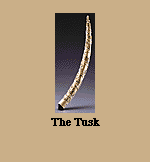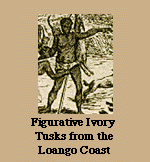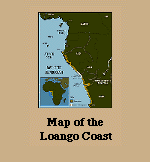

|
|
|
|||
 By the 19th century, after several centuries of contact and trade
with Europe, workshops specializing in carving export objects
for the foreign trade were established along the Loango coast.
These workshops produced objects in wood, soapstone, and ivory
for sale to both Europeans and Africans. Export objects in ivory
included cane handles and stamps for sealing wax. The most
famous objects in ivory, however, were carved figurative tusks
that ranged from 20 centimeters to one meter (eight inches to
three feet) in length. Using iron tools, artists carved African and
European figures engaged in activities of daily coastal life in
relief on the tusks. The artists carved and arranged the figures to
heighten the naturalism and expressive power for which Kongo
art is famous, paying great attention to detail--dress, hairstyles,
gestures, and comportment. The scenes were carved and
probably meant to be read starting at the base and ending at the
top. This lively tradition of genre art in ivory lasted from about
1850 to 1900.
By the 19th century, after several centuries of contact and trade
with Europe, workshops specializing in carving export objects
for the foreign trade were established along the Loango coast.
These workshops produced objects in wood, soapstone, and ivory
for sale to both Europeans and Africans. Export objects in ivory
included cane handles and stamps for sealing wax. The most
famous objects in ivory, however, were carved figurative tusks
that ranged from 20 centimeters to one meter (eight inches to
three feet) in length. Using iron tools, artists carved African and
European figures engaged in activities of daily coastal life in
relief on the tusks. The artists carved and arranged the figures to
heighten the naturalism and expressive power for which Kongo
art is famous, paying great attention to detail--dress, hairstyles,
gestures, and comportment. The scenes were carved and
probably meant to be read starting at the base and ending at the
top. This lively tradition of genre art in ivory lasted from about
1850 to 1900.
Many Loango tusks are in private and public collections throughout Europe and the United States. Because they have never been studied systematically, information about their original locations along the Loango coast remains tentative. While the styles, expressions, and arrangements of figures on the tusks clearly place them within the realm of Kongo art, differences in quality and individual characteristics point to individual hands and/or workshops. During the 19th century, when many of the tusks were carved, the Loango coast experienced significant changes. The old Loango Kingdom broke up and new groups, drawn to the lucrative commercial life, moved to the coast. It is possible that, in addition to Vili artists, artists from other Kongo or neighboring groups worked in the ateliers carving tusks and other objects for export. |
|||

|

|

|

|
|
Back to: NMAfA past exhibits |
|||